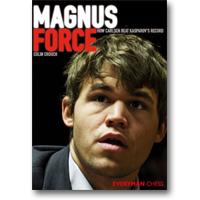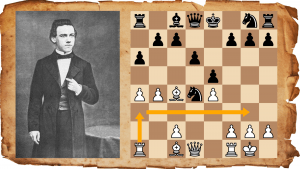
Review: Magnus Force
Magnus Carlsen is a phenomenon. He could recently be seen on enormous billboards all over the world posing next to supermodel and Lord of the Rings actress Liv Tyler; he’s been a guest to The Colbert Report; and he has featured on the cover of Time magazine. But why, precisely, is he such a phenomenon? This has always slightly puzzled me.
Few people still doubt that Carlsen is, with some margin, the best player in the world, but so were Anand and Kramnik before him – yet as far as I recall they never featured on billboards next to supermodels. Carlsen’s popularity can, in fact, only be compared to that of former chess World Champions Garry Kasparov and Bobby Fischer. Carlsen has already been called ‘the Mozart of chess’. Apart from the terrible cliché, the comparison makes one wonder who might be the Bach, Beethoven and Schubert of chess, and whether these composers/players should be considered less ‘brilliant’. But any way you look at it, the 22-year-old Norwegian boy is only the third world-wide chess celebrity in history.
Carlsen will be playing his first World Championship match this November, in Chennai, India, against the reigning champ, Vishy Anand. This is arguably going to be Magnus’ first real test. It’s been great so far, but the real stuff is yet to come. As an appetizer for that upcoming clash of generations, Everyman Chess has recently published Magnus Force – How Carlsen beat Kasparov’s Record, written by IM Colin Crouch.
The author’s goal is pretty clear from the Introduction:
The core of this book is to analyse all the games by Magnus Carlsen, in the London Classic, December 2012, and Wijk aan Zee, January 2013. This is just a small segment in time, but it is clearly the start of a new chapter of chess history.
It must be said that Crouch does a really good job achieving just that. His analyses are instructive, entertaining, honest, and most of all very, very thorough.
The first chapter alone is a masterstroke: Crouch starts off by taking a close look at a number of Carlsen’s recent losses. This approach is reminiscent of Edmar Mednis’ classic How to Beat Bobby Fischer and works very well to set the scene in Magnus Force, too: Crouch clearly doesn’t want to come across as yet another Carlsen fanboy and there’s really no better way to get that prejudice out of the way then by starting with the exceptionally poor form Carlsen displayed in 2010 and the start of 2011. About the 2010 London Chess Classic, for instance, Crouch says:
It has to be said that by general consensus, Carlsen was in a grumpy mood during the early part of the tournament, and was not all that talkative in the press conferences. Still, this is hardly surprising. A loss in a serious game of chess can badly affect the emotions, and all the more so if there is a second loss, not long after. It is difficult to hide such feelings on such occasions, all the more so, given that Carlsen had only just hit twenty. (…) His mood became darker when he lost to Vishy Anand in round 3 (after a win against Adams). No wonder.
A typical example of Crouch’ method of analyzing Carlsen’s strengths and weaknesses is the following, from the same ‘dark’ period.
Carlsen-Nepomniatchi
Wijk aan Zee, 2011
There is plenty of tension in the centre, and there is a central isolated pawn on each side, with possible battles over the d4-, d5- and e5-squares. As we shall see, the ‘natural’ result for both sides would be a quick draw by repetition. Carlsen’s attempt to break the symmetry proved to be unwise, although agreed, it is difficult to foresee all this.
When comparing this game by Carlsen (a loss against Nepomniachtchi), and his win three days earlier against Nakamura, an interesting strategical point can be noted. The central tension is clear in both games. In the earlier game, there was additional tension on both sides of the board, with Carlsen being able to keep pressure on the kingside, and Nakamura having pressure on the queenside. This meant that Carlsen was able to keep the pressure going, without having to worry about giving away anything in the centre. In contrast, against Nepomniachtchi, as soon as he tried to do anything on the queenside, losing even momentarily the central battle, it was his opponent who was able to take the initiative.
After the tournament, Carlsen would no doubt have gone through these two games in great depth, and drawn his own conclusions.
Here and elsewhere, Crouch shows great insight when it comes to the nuances of chess psychology, which Carlsen masters like few before him. He convincingly argues that Carlsen’s playing style is highly reminiscent of that of the second World Champion, Emanuel Lasker:
All the time, he is thinking very much about his opponent, almost as much as the board. Naturally, like Lasker, he has an extremely deep understanding of the position, and given a straightforward technical edge, he will try to convert this without too much trouble. (…) The chess psychologist, gifted also with exceptionally clear thinking, will be trying to give himself every opportunity for his opponent to make a mistake, whether before move ten, or by move twenty, thirty, forty, or whatever. Carlsen also tries to grind out his opponent in the endgame, often a long way into the second session.
Carlsen, when playing against an opponent that he knows well, and an opponent he has analysed in depth, will tend to grasp very quickly his opponent’s strengths or weaknesses. In preparing his openings, he will not try to catch up with the latest analysis twenty moves deep. He would be thinking instead of which sort of opening would make his opponent feel slightly uncomfortable, and therefore more likely to make a mistake. (…)
Carlsen excels under pressure in positions when he is worse, and also in strategically complicated positions in which both players are forced to play with great care. He is not quite so convincing when it looks as if he is clearly better, and it seems a matter of technique to haul in the full point. Often he seems to try to make life complicated, when all that is needed is simple chess. Of course, if the position is genuinely complicated, and requires difficult decisions on both sides, Carlsen is very much in his element.
Whilst such fragments reveal telling glimpses of what makes Magnus Carlsen tick (and what doesn’t), the psychological explanations tend to be mostly chess-related. In order to overcome his bad form, Crouch quotes Kasparov who says that Magnus “needs to work harder to maintain his sharpness”. Crouch himself describes how Carlsen “dusts himself down, taking things move by move, and game by game”.
Only once or twice, circumstances that have nothing to do with chess are mentioned, such as the horrible terrorist attacks by the lunatic Anders Breivik, on 22 July 2011, which caused Carlsen to write on his blog that “chess does not feel very important right now” – although Crouch duly notes that it didn’t prevent him from beating Fabiano Caruana the next day.
Here’s another example of Crouch’s down-to-earth analysis style and reasoning:
Carlsen-Jones
London Chess Classic, 2012
16.Ba3
Carlsen plays the most complicated line available. It is not necessarily the case that he genuinely wants complicated tactics. It is more a case that he would not want his pawn structure to be messed up after 16 Nxa4 (16 bxa4 Nxa4 17 Nxa4 Rxa4 will soon transpose) 16...Nxa4 17 Bxg7 Kxg7 18 bxa4 Rxa4. White can probably equalize with reasonable care after 19 Rd2 Qa5 20 Nd4 Nxd4 21 Qxd4+ Rf6 22 Qe3, but why should Carlsen bother with this? His instincts would be that his position so far should be at least equal (from the diagram position), rather than at best equal, and so he would prefer to enter what was likely to be some complications. Perhaps both players would have been thinking about playing for an edge?
Convincing stuff, and the book’s full of it. Page after page, Crouch breaks down the elements of Carlsen’s play and links the individual moves back to his overall evaluation of how Carlsen wins (and sometimes loses) most of his games. By taking a close look not only at Carlsen’s moves, but also at his motives for playing them, Crouch manages to paint a strikingly well-argued picture of what makes Carlsen such an outstanding player.
And yet, I felt strangely disconnected when I put the book down and tried to think of what, precisely, makes Carlsen not only such a great player but also such a global phenomenon. After all, there are other players who play more or less equally well, or only slightly less well anyway. Why, then, is Carlsen also the appealing role model for an entire generation that he currently is? Why is almost everybody whom I speak to so excited that he will be playing Anand, and not, say, such sympathetic guys like Levon Aronian, Sergey Karjakin or Alexander Grischuk?
Magnus Force doesn’t answer this question, nor, to be fair, does it try to, as Crouch himself says in the Introduction:
No attempt has been made here to try any sort of standard biography (Carlsen learning how to play, Carlsen as a junior, etc). There are other players far better placed to write something much more detailed and informative; Simen Agdestein for a start. (…) I have not talked directly with Magnus Carlsen, and in some ways this is not totally a bad thing. I have the freedom that this is not an ‘authorised biography’, and the responsibility is not to write anything too daft.
And indeed, words like ‘childhood’, ‘family’ and ‘friend’ are conspicuously missing in Magnus Force, as are ‘television’, ‘girlfriend’ and ‘Liv Tyler’. Even the word ‘father’ is absent. All this means that Magnus Force tells only half the story, which is still a pity. As the secret of Carlsen’s superstar status isn’t his attractive playing style (Crouch makes that very clear), nor his outspoken views on (chess) politics - or anything else for that matter (except perhaps football), there must be an altogether different dimension to Magnus Carlsen’s success that isn’t revealed in Crouch’s book.
But what is it? Could it be that it’s precisely that absence of other aspects that make Carlsen such an attractive role model for chess? Looking at his predecessors, they all seem to have had ‘something else’ they were associated with: Kasparov with politics, Karpov with the Soviet regime, Fischer with his paranoia. Carlsen, by contrast, seems to be just chess - the most perfect embodiment of pure, uncomplicated chess to date. Which is why Magnus Force may not be limited because of its intended scope after all - but because of its subject.
This review was written by Arne Moll. Arne has been a reviewer & columnist for years at ChessVibes, and he is joining Peter Doggers and José Diaz here at Chess.com!






